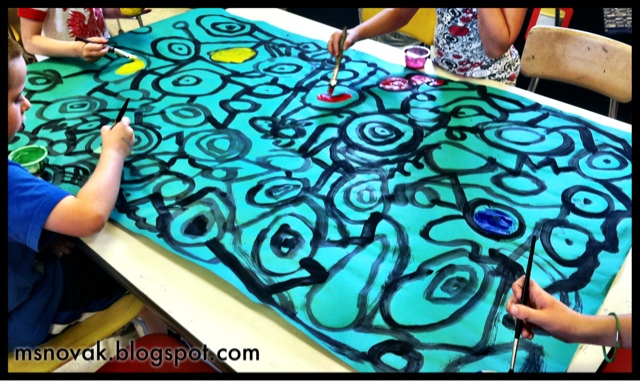I started this project a couple of years ago and loved it so much, I just keep on doing it.

Day 1: The very first day I hand out paper and ask students to draw their very best self-portraits. I ask they to draw their heads large, show a their neck and shoulders. I stress that students can't let other students draw parts of their face for them - even if they like how someone else draws eyes over their own.
The next few classes we spend practicing different sections of the face.
Day 2: I show a slide show of real eyes - close up. I ask them to notice the shapes, colors, patterns, textures. We pause it on one eye and break it all down - shape of the eye, shape of the colored part - do we see the whole part of the colored part?! (I stress that ALL eyes are different - some people see the whole colored part, but most only see part). Then we talk about the pupil - what is the purpose, what happens when we go from BRIGHT light to DARK and reverse. The kids get a kick out of learning why it hurts to turn on lights in a dark space. We then talk about the colored part - what does it really look like?! Is it one solid color?! Does it change?!
Rest of the class we practiced drawing different eye shapes, colored part, pupil and such. I asked the students to practice finding the combination of colored pencils/crayons that made their own eye color.
I passed out mirrors to help them observe their true eye color.
Day 3: We reviewed their eyes, talked about where eyes go on their head. I projected pictures of me when I was little onto the white board. I trace my head, trace my eyes and ask where my eyes are at on my head. I then cover the projector and ask again. I almost always get "Ooooh! - In the middle!" I then do this again with an older picture of myself and my older brother - trying to prove to them that their eyes are indeed in the middle of their head. Mirrors were provided.
 |
| http://www.pencildreams.com/2011/03/drawing-nose.html |
Next, I ask the students to start their final head, put their eyes in the middle, color them. If, when, they get done with this step they get a sheet that has practice noses on it. I ask the students to doodle noses for the rest of class. I explain that I will no longer accept "b, d, c, L," or any version of those letters for noses. The sheet I pass out is very cartoon-y, but it still gets them to start doodling noses with some nose-like shapes and lines.
Day 4: We practice some more noses - talk about where their nose goes on their paper (nose starts between the eyes and ends halfway between their eyes and chin). Final noses go on paper. Students the practice lips for the remainder of the class. Mirrors were provided.
Day 5: Students review/practice lips and draw their lips halfway between their nose and chin. Next, I explain how to do their hair. We look at common mistakes boys and girls make -- creating weird bald spots. They giggle and explain why it looks wrong. I then have students draw their hair line (not their hair), show it to me and they start to color! Most kids can finish coloring this class period, but some need another day. I really stress to them that they need to get colors as close to real as possible - that meant A LOT of students had to layer colors for their skin color and their lip color. Mirrors were provided.

END: I have students compare and contrast their pre and post drawings. It is great to see these side by side - the students often are wide eyed at their before picture.










































.JPG)
